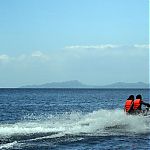 Jack Rosenthal, CBE
Jack Rosenthal, CBE (
8 September 1931 -
29 May 2004) , was an
English playwright, who wrote 129 early episodes of the
ITV soap opera Coronation Street and over 150 screenplays, including original TV plays, feature films, and adaptations.
He was born in
Cheetham Hill,
Manchester, and after studying English Literature at
Sheffield University and carrying out his
National Service in the
Royal Navy he worked briefly in
advertising before joining
Granada Television and becoming a regular writer for the groundbreaking soap
Coronation Street. During the 1960s, he wrote material for various television comedy shows including the satirical
That Was The Week That Was. At
Granada Television, he wrote a spin off series from
Coronation Street for the character, Leonard Swindley, played by
Arthur Lowe called
Pardon the Expression and created the comedy series
The Dustbinmen and
The Lovers (TV series) starring Richard Beckinsale. In1976 he also wrote a TV drama for ITV, called
Ready When You Are, Mr McGill, which was later remade in 2003.
Rosenthal won three
BAFTA awards for
Bar Mitzvah Boy (about a Jewish boy's
Bar Mitzvah),
The Evacuees (based in his own war-time
evacuation) and
Spend, Spend, Spend (about a
football pools winner,
Viv Nicholson). He also wrote
The Knowledge, a film about London taxi-drivers which has become a classic for cabbies-in-training. He created
London's Burning as a one-off drama in
1986, and this later developed into a long-running TV
drama.
In
1983, Rosenthal co-wrote the film
Yentl with
Barbra Streisand. He also did uncredited work on the screenplay of
Chicken Run.
Rosenthal also wrote the book for the musical version of
Bar Mitzvah Boy, with music by
Jule Styne.
He married actress
Maureen Lipman in
1974, and they have two grown-up children, writers Amy and Adam Rosenthal.
Rosenthal was awarded the
CBE in
1994.
He died on
29 May 2004, following a long battle against
multiple myeloma, a form of
cancer.
His autobiography,
By Jack Rosenthal was published posthumously and a four-part adaptation by his daughter, titled
Jack Rosenthal's Last Act was broadcast on BBC Radio 4 in July 2006 starring Maureen Lipman as herself and Stephen Mangan as Jack Rosenthal.
 See also
See also

 The article could be improved by
The article could be improved by 



 Early life, family and education
Early life, family and education Early examples
Early examples Naturalisation in the United Kingdom
Naturalisation in the United Kingdom Singapore
Singapore

 History
History
 People and culture
People and culture